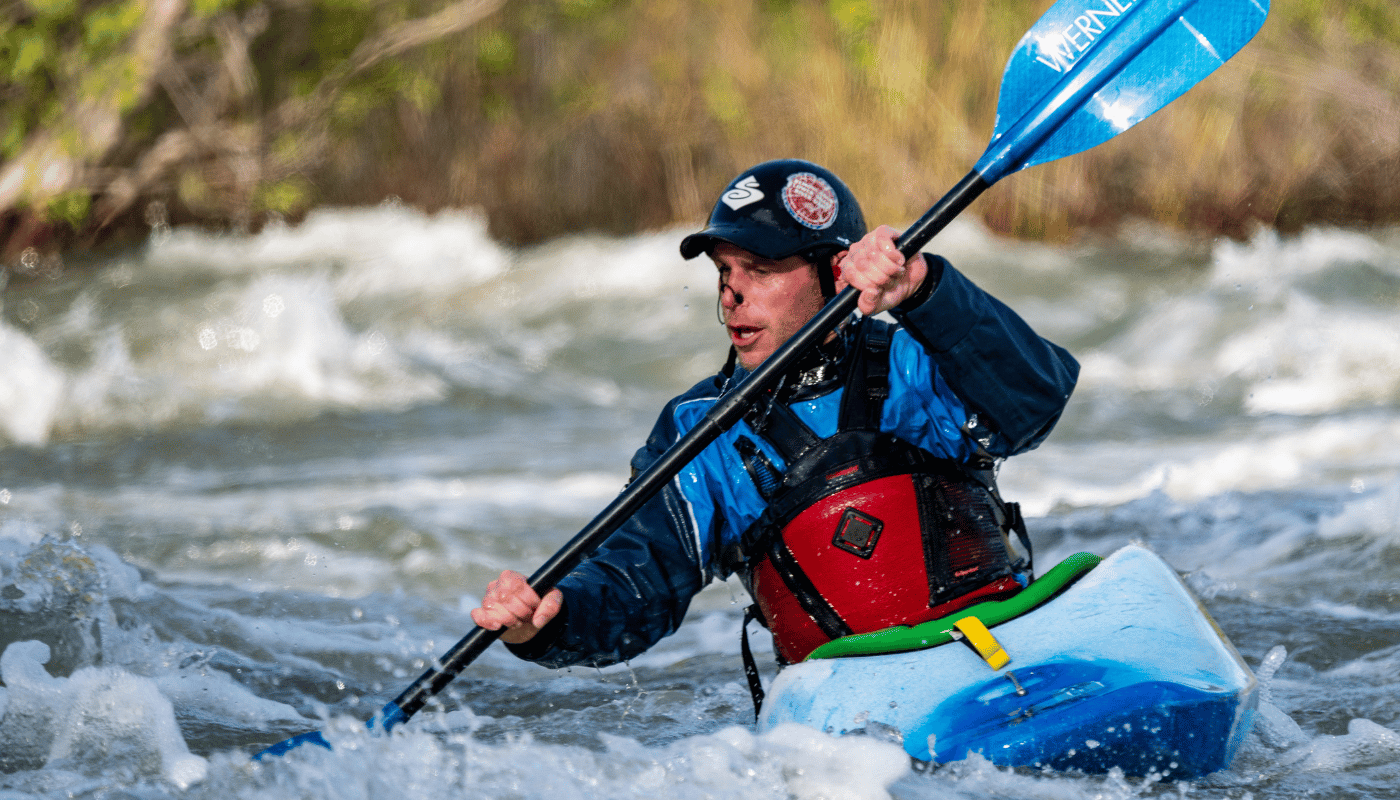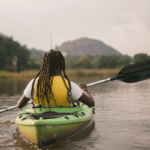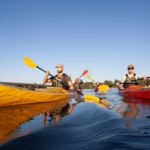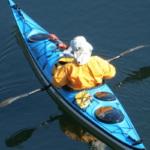Kayaking is an exhilarating way to explore the beauty of waterways, from tranquil lakes to rushing rivers. Whether you’re paddling through calm waters or navigating challenging rapids, being well-prepared is essential for a safe and enjoyable experience. One of the most important aspects of preparation is knowing what to wear on a kayak. Proper clothing not only ensures comfort but also plays a critical role in safety and performance.
When you’re on the water, environmental conditions can change rapidly. The right attire helps protect against risks like hypothermia, sunburn, or chafing. For instance, kayaking in colder waters requires insulation to retain body heat, while hot and sunny conditions call for lightweight, breathable fabrics to stay cool. Additionally, water-resistant clothing can shield you from splashes and sudden rain, keeping you dry and comfortable throughout your journey.
Beyond comfort, appropriate clothing is a safety measure. Kayaking often involves exposure to water and weather extremes, and wearing the wrong materials—such as cotton—can lead to discomfort or even dangerous situations. Cotton absorbs water and dries slowly, making it unsuitable for paddling adventures. On the other hand, synthetic fabrics and neoprene are excellent choices for wicking moisture and providing insulation.
Kayaking attire also varies depending on the type of activity. A leisurely paddle on a warm day might require little more than a quick-dry outfit, while sea kayaking or whitewater adventures demand additional protective layers and gear. Regardless of the conditions, being dressed appropriately can make all the difference between a memorable day on the water and an uncomfortable experience.
Key Considerations When Choosing What to Wear on a Kayak
it’s important to consider several factors that can influence your comfort and safety. Kayaking is a dynamic activity, and the right clothing will help you stay dry, warm, and protected from the elements. Here are the key factors to keep in mind:
- Weather Conditions: Temperature, humidity, and wind all play a major role in your clothing choices.
- Water Temperature: Cold water can cause hypothermia if you’re not properly dressed.
- Activity Type: Whether you’re kayaking for relaxation or taking on whitewater, your clothing needs will differ.
- Movement: Flexibility is crucial, so avoid bulky clothes that restrict movement.
- Sun Protection: UV protection is essential, especially if you’ll be out on the water for an extended period.
Each of these factors should guide your clothing choices. For example, on a hot day, lightweight, moisture-wicking fabrics will help keep you cool and dry. Conversely, for colder conditions, layering with moisture-wicking base layers and insulating materials like fleece is recommended to trap warmth while keeping you dry. If you’re kayaking in more extreme conditions, wearing a wetsuit or drysuit might be necessary for added protection.
The activity type also influences your decision. Casual kayaking on calm lakes calls for comfortable, breathable clothing, while more intense activities like whitewater kayaking demand quick-drying materials and specialized gear to protect against potential impacts or capsizing.
Essential Gear for Kayaking: What You Can’t Forget
When preparing for a kayaking adventure, it’s not just about what to wear on a kayak, but also the essential gear and safety considerations—especially if you’re planning to kayak alone, making it crucial to research our article how safe it is.
First and foremost, a life jacket is non-negotiable. Safety is paramount, and a properly fitted personal flotation device (PFD) ensures that you remain afloat in case of an accident. PFDs come in various styles, so be sure to choose one that suits your kayaking activity.
Another essential item is a paddle. Selecting the right paddle size and material will influence your stroke efficiency and comfort. For longer trips, a lightweight paddle reduces fatigue, while a stronger paddle is necessary for whitewater kayaking.
Waterproof bags are also a must, as they allow you to store your valuables and extra clothing without worrying about them getting wet. It’s also advisable to carry a whistle or signaling device, especially when kayaking in remote areas, to ensure you can attract attention if needed. Additionally, a helmet is recommended for more extreme kayaking activities, such as whitewater kayaking, where the risk of head injury is higher. The helmet should fit snugly and provide adequate protection against impact.
Choosing Clothes for Different Weather Conditions
When preparing for a kayaking adventure, the weather plays a major role in determining. Whether you’re kayaking in hot summer sun or chilly waters, choosing the right clothes ensures your comfort and safety. Below is a helpful comparison of clothing choices based on different weather conditions.
| Weather Condition | Recommended Clothing | Purpose |
| Cold Water/Weather | Wetsuit or drysuit, thermal layers, waterproof jacket | Insulation, warmth retention, protection from hypothermia |
| Hot Weather | Lightweight, moisture-wicking fabrics, sun protection | Comfort, breathability, UV protection |
| Rainy Conditions | Waterproof jacket, quick-drying clothes | Stay dry, avoid discomfort and chafing |
| Mild/Moderate Weather | Light fleece or jacket, long-sleeve shirt, leggings | Versatility, warmth, protection from sun and insects |
In colder water or weather conditions, wearing a wetsuit or drysuit becomes essential. These garments help trap body heat and prevent hypothermia, a real risk when exposed to chilly waters for extended periods. For warm weather, lightweight and moisture-wicking fabrics should be your go-to. These fabrics allow air to flow and moisture to evaporate, keeping you cool and comfortable. For sunny conditions, it’s crucial to wear clothing that protects your skin from UV rays, such as a long-sleeve rash guard or UV-protective shirt.
If you’re expecting rain, it’s advisable to pack a waterproof jacket and quick-drying clothes. These will keep you comfortable and prevent unnecessary chafing while you paddle through wet conditions. Finally, mild weather calls for a balance of layers, such as a light fleece or jacket. These options give you flexibility and are suitable for both sunny and cooler moments during the day.
Materials That Work Best for Kayaking Clothing
When choosing what to wear on a kayak, the materials of your clothing can significantly impact your comfort and performance on the water. Certain fabrics offer unique benefits that help you stay dry, comfortable, and protected from the elements during your kayaking adventure.
Neoprene is one of the most popular materials for cold water kayaking. It’s a synthetic rubber material that provides thermal insulation by trapping water between the fabric and your skin, which is then warmed by your body heat. This makes neoprene a great choice for wetsuits or drysuits in cooler conditions. It’s designed to keep you warm even when it gets wet, making it a must-have for anyone kayaking in chilly waters.
For warmer weather, polyester and nylon are lightweight, breathable, and quick-drying materials that are ideal for sun protection. These fabrics are often used in shirts, shorts, and jackets designed for kayaking. They wick away moisture, keeping you dry and comfortable, while also offering UV protection, which is especially important if you’re paddling under the sun for extended periods.
Polypropylene is another excellent fabric choice. It’s commonly used in base layers because it’s moisture-wicking, meaning it draws sweat away from your skin to keep you dry. Since staying dry is crucial when kayaking, this material is especially beneficial when worn in layers to help regulate your body temperature.
Each of these materials serves a specific purpose based on the weather conditions and the level of kayaking activity. Choosing the right combination can make a significant difference in how you feel during your time on the water, ensuring that your clothing works with you rather than against you.
Common Mistakes to Avoid When Dressing for Kayak Adventures
When it comes to what to wear on a kayak, many beginners make the mistake of not choosing the right clothing, which can result in discomfort, chafing, or even dangerous situations. Avoiding these common mistakes will help you stay comfortable and safe throughout your kayaking adventure. Here are some key mistakes to avoid:
- Wearing Cotton Clothes: Cotton absorbs water, leaving you wet and cold, which can lead to hypothermia in cooler conditions.
- Overdressing for Warm Weather: Wearing too many layers can cause overheating and discomfort.
- Neglecting Sun Protection: Failing to wear UV-protective clothing can leave you vulnerable to sunburns.
- Choosing Inflexible Clothing: Tight or bulky clothes restrict movement, making it harder to paddle effectively.
- Not Considering Water Temperature: Wearing clothing meant for warmer conditions in cold water can lead to discomfort and even safety risks.
These common mistakes are easy to avoid with a little forethought and preparation. One of the biggest errors kayakers make is opting for cotton clothing. Cotton is incredibly absorbent, and once it gets wet, it stays wet. This can make you feel cold and uncomfortable, especially in cooler water or during long paddles. Instead, always opt for moisture-wicking materials like polyester or specialized kayaking fabrics that dry quickly.
Another mistake is wearing too many layers on a warm day. It’s important to dress in layers that allow you to adjust based on your activity level and the temperature. If you’re paddling in the heat, lightweight, breathable clothing is your best bet. Don’t forget to pack sunscreen or wear clothing with built-in UV protection, as prolonged exposure to the sun can lead to sunburn.
Lastly, clothing that restricts your movement will make paddling difficult and uncomfortable. It’s essential to choose gear that allows freedom of motion, such as flexible and form-fitting fabrics, so you can paddle with ease. Keeping these tips in mind will ensure you’re properly dressed for your kayaking experience, allowing you to focus on the fun, not your discomfort.
Conclusion
In conclusion, choosing what to wear on a kayak is a critical decision that directly impacts your comfort, safety, and enjoyment on the water. By considering factors such as weather conditions, water temperature, and the type of kayaking you’re doing, you can select the best clothing and gear for your adventure. Proper preparation is key, and wearing the right clothing ensures you stay comfortable and protected throughout your trip.
One of the most important tips to remember is to avoid cotton clothing, as it retains water and can leave you cold and uncomfortable. Instead, opt for moisture-wicking, quick-drying fabrics that keep you dry and comfortable, especially during long hours on the water. Always consider layering your clothing, as this allows you to adjust according to changes in weather or water conditions.





